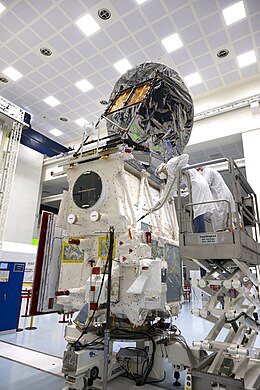 EarthCARE being prepared for shipment to launch site | |
| Mission type | Earth observation |
|---|---|
| Operator | ESA / JAXA / NICT |
| COSPAR ID | 2024-101A |
| SATCAT no. | 59908 |
| Website | EarthCare on esa.int |
| Mission duration | 3 years (planned) 5 months, 26 days (in progress) |
| Spacecraft properties | |
| Bus | AstroBus-L |
| Manufacturer | EADS Astrium |
| Launch mass | 2350 kg[1] |
| Dry mass | 2037 kg[1] |
| Dimensions | 2.5 x 19 m |
| Power | 1700 W |
| Start of mission | |
| Launch date | 28 May 2024 22:20 UTC[2] |
| Rocket | Falcon 9 Block 5[3] |
| Launch site | Vandenberg SLC-4E |
| Contractor | SpaceX |
| Orbital parameters | |
| Reference system | Geocentric |
| Regime | Sun-synchronous |
| Altitude | 393 km |
| Inclination | 97,1° |
| Period | 92,5 minutes |
| Repeat interval | 25 days |
| Epoch | Planned |
| Transponders | |
| Band | S Band (TT&C support) X band (science data acquisition) |
| Bandwidth | 2 Mbit/s download (S Band) 150 Mbit/s download (X Band) 64 kbit/s upload (S Band) |
| Instruments | |
| ATLID: ATmospheric LIDar CPR: Cloud Profiling Radar MSI: Multi-Spectral Imager BBR: Broad-Band Radiometer | |

| |
EarthCARE (derived from Earth Cloud, Aerosol and Radiation Explorer), nicknamed Hakuryū (Japanese for "white dragon"),[4] is a joint European/Japanese (ESA / JAXA / NICT) satellite, the sixth of ESA's Earth Explorer Programme.[1][5] The main goal of the mission is the observation and characterization of clouds and aerosols as well as measuring the reflected solar radiation and the infrared radiation emitted from Earth's surface and atmosphere.[6][7][8]
- ^ a b c Eisinger, Michael; et al. (26 November 2018). EarthCARE The Earth Cloud, Aerosol and Radiation Profiling Satellite Mission (PDF). ATMOS-2018. Salzburg, Austria: ESA. Retrieved 27 May 2019.
- ^ https://www.esa.int/Newsroom/Press_Releases/EarthCARE_launched_to_study_role_of_clouds_and_aerosols_in_Earth_s_climate
- ^ Foust, Jeff (29 June 2023). "Vega C suffers setback in return to flight effort". SpaceNews. Retrieved 2 July 2023.
- ^ "The White Dragon". www.esa.int. Retrieved 2024-05-27.
- ^ "EarthCARE out of the box". www.esa.int. Retrieved 2024-04-18.
- ^ "EarthCARE - Earth Online - ESA". ESA. Retrieved 19 September 2017.
- ^ Illingworth, A. J.; Barker, H. W.; Beljaars, A.; Ceccaldi, M.; Chepfer, H.; Clerbaux, N.; Cole, J.; Delanoë, J.; Domenech, C.; Donovan, D. P.; Fukuda, S.; Hirakata, M.; Hogan, R. J.; Huenerbein, A.; Kollias, P.; Kubota, T.; Nakajima, T.; Nakajima, T. Y.; Nishizawa, T.; Ohno, Y.; Okamoto, H.; Oki, R.; Sato, K.; Satoh, M.; Shephard, M. W.; Velázquez-Blázquez, A.; Wandinger, U.; Wehr, T.; van Zadelhoff, G.-J. (2015). "The EarthCARE Satellite: The Next Step Forward in Global Measurements of Clouds, Aerosols, Precipitation, and Radiation" (PDF). Bulletin of the American Meteorological Society. 96 (8): 1311–1332. Bibcode:2015BAMS...96.1311I. doi:10.1175/BAMS-D-12-00227.1. ISSN 0003-0007. S2CID 122041433.
- ^ "EarthCARE (Earth Clouds, Aerosols and Radiation Explorer)". eoPortal. ESA. Retrieved 30 October 2013.